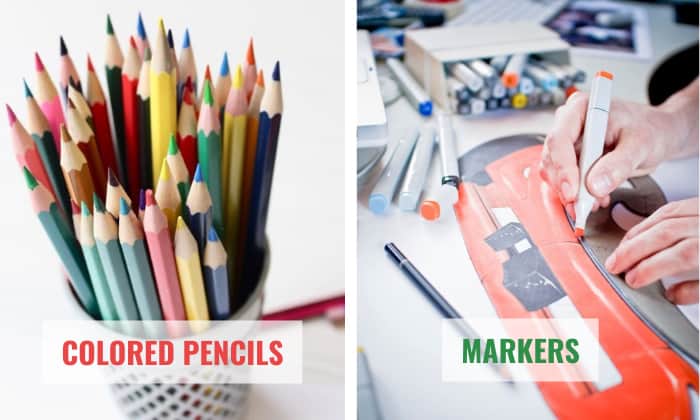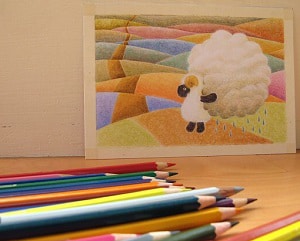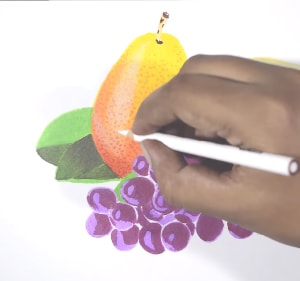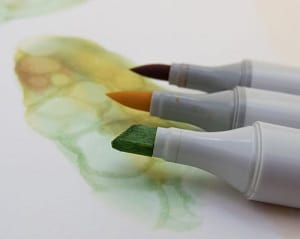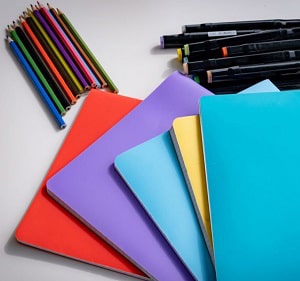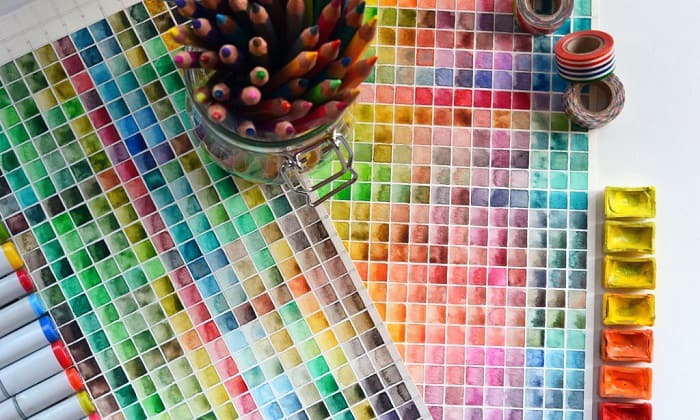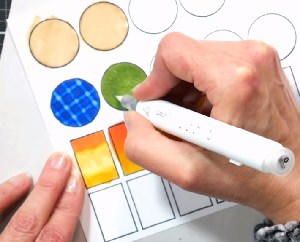Colored pencils and markers are two different art media that can showcase your creativity and shading techniques. No wonder many artists choose colored pencils or markers as their primary medium to elevate their color palette and express their artistic ideas.
That said, studying their characteristics helps hobbyists and art aficionados to find the best medium for their needs and preferences.
In this article, we will dig deeper into the world of colored pencils vs markers to highlight their performance as well as determine their benefits and pitfalls.
Table of Contents
What is the Difference Between Colored Pencils and Markers?
1. Colored Pencils
Colored pencils are easy to control. When sharpened, the sharp tips are all about precision, allowing you to render artistic ideas with detailed strokes, natural sketches, and soft tones. Plus, they are affordable and accessible to beginner artists.
However, working with colored pencils requires more pressure and time to cover large-scale projects or vast surfaces. Nonetheless, colored pencils are a dry medium, so you can define strokes and combine different shades effortlessly.
2. Markers
Markers appeal to many experienced and professional artists because of their vibrant hues, wide color selection, and impressive blendability. Various nib styles and sizes make markers a lot more versatile than colored pencils when shading or drawing.
Compared to colored pencils, markers are more permanent, being able to preserve the color quality for the longest time possible.
However, since they use ink, markers tend to bleed or smudge when not handled carefully. Various shading and drawing techniques will help minimize these pitfalls.
Breakdown of Features
1. Composition and Application
Colored pencils utilize lead that is typically composed of wax, filler, pigment, and a binder inside a cedar or wooden case. Markers use liquid ink encased in a barrel that supplies the nibs with pigmented fluid.
Due to their different composition, you’ll be able to see a clear difference when comparing colorful drawings with markers and colored pencils.
For instance, Prismacolor pencils (Premier) have soft cores that lay down colors smoothly, producing vibrant and highly blendable pigments.
Meanwhile, markers may not be as precise as colored pencils, but they can lay down colors more effortlessly. The ink flows smoothly through the nibs, producing solid and highly pigmented shades to cover large surfaces.
2. Variations
Colored pencil art may appear differently based on the variation used to draw and fill the colors. Colored pencils have either soft or hard cores, which can be oil-based, wax-based, and water-soluble.
You may also expect various consistencies and effects when you draw with markers. Markers may either use alcohol- or water-based ink to produce vibrant colors or soft tones.
3. Blending Capabilities
Colored pencils have better blending capabilities compared to markers. You can layer the colors, create effects, and produce seamless gradients and brand-new hues.
However, it requires a learning curve to master the blending of colored pencils. It may also depend on the quality and type of colored pencils; hard-cored pencils are difficult to blend, whereas soft ones build and blend colors more seamlessly. Moreover, high-end brands may give more prominent color blends.
Markers, on the other hand, are generally highly blendable. However, their blending capabilities usually depend on the ink type (alcohol-based or water-based). In this case, alcohol-based coloring pens, such as Copic markers, have better blendability.
Overall, practicing and applying color pencil and marker techniques might be needed to achieve seamless color blends.
4. Color Quality and Saturation
Both markers and colored pencils have a stunning range of colors that can render vibrant and natural hues.
Looking into the marker and colored pencil drawing samples, you may notice that colored pencils give off sketching strokes that create softer tones and precise color quality.
Markers, on the other hand, deliver rich and intense tones that can amplify your artwork with remarkable pops of colors.
5. Versatility
Colored pencils are all about versatility; you can create realistic features and smooth gradients, even when mixed with other media. When you draw sand with colored pencils, creating realistic dirt or smooth sand textures is achievable.
However, colored pencils do not have available nibs as markers do. Markers usually come with a variety of nib types: brush, chisel, fine, and bullet.
6. Drying time and Paper bleed
Colored pencils never bleed and do not require any drying time. In contrast, markers should be given enough time to dry to prevent smudges or streaky finishes.
When applied on thin sheets, markers, especially alcohol-based ones, tend to bleed through. For that reason, choosing the compatible paper type for your markers is crucial.
Although some markers are fast-drying, it is better to allow them to dry completely to minimize bleeding. In addition, you can place an absorbent sheet underneath the paper to soak up the excess ink.
7. Precision and Control
As many Reddit reviews say, colored pencils are easy to work with, unless when it comes to blending. And since they do not use ink, there is no worrying about bleed throughs or messy smudges. You may also sharpen the lead for maximum precision.
In contrast, as markers are prone to smudges, bleeding, and feathering, you’ll need to master proper techniques to avoid such issues.
8. Ease of Use
Colored pencils are light, portable, and easy to use. Markers are generally bulkier than colored pencils and tend to leak when not properly stored.
Fortunately, some markers are light and travel-friendly, depending on the type or brand. Ergonomic shapes and sizes are available for both colored pencils and markers.
9. Longevity
Markers last longer than colored pencils. Some even have refillable ink cartridges and replaceable nibs. Many brands offer premium quality ink that delivers lightfast colors to preserve the artwork’s beautiful hues.
Colored pencils tend to fade over time. But artwork drawn or painted with oil-based colored pencils may last longer than usual when stored in a cool place and from direct sunlight.
10. Safety
Colored pencils may pose minimal safety risks because of their sharp edges, pencil shavings, or residues from broken cores. Small children should also be supervised to avoid choking hazards.
On the other hand, the risk with markers is the ink because of its strong odor or chemical content, particularly from alcohol markers. Fortunately, many manufacturers now employ environmentally friendly and organic materials to prevent any health risks.
Needless to say, the safety concerns between color pencil vs alcohol marker pens are easily addressed with proper use, storage, and opting for high-quality products from well-known brands.
11. Price
Colored pencils are more affordable than markers. You can avail of a good set of coloring pencils for adult coloring books for as low as $3, which is typically the same cost as an individual marker. Meanwhile, a decent set of markers usually starts at $6 to $10.
The brand and color count usually affect the costs. Despite that, colored pencils are still relatively much cheaper than markers. For example, the 48-set of Arteza colored pencils may cost around $30, whilst the 48-set of Arteza markers usually sell for $40.
Pros & Cons
Colored Pencils
- Delivers soft tones
- Creates detailed and precise strokes
- Blends very well
- Easy to use and control
- Does not require drying time
- Cheap and accessible to beginner artists
- Ideal only for precise application and detailed strokes
- Needs to be sharpened for better results
- Sharp edges that may be dangerous to small kids
- May fade over time
Markers
- Produces vibrant and highly pigmented colors
- Offers excellent saturation that can easily cover large areas
- Available in different nib styles and sizes for maximum versatility
- Long-lasting; Has refillable options for excellent longevity
- Available in different ink types
- Offers a vast range of colors
- Blends well with proper techniques applied
- Has affordable options
- Tends to bleed through thin paper
- Requires drying time to avoid smudges, bleeding, or feathering
- Some alcohol markers have a strong odor
- Typically expensive in larger sets
How to Shade With Colored Pencils and Markers
Since markers are prone to bleeding, choosing the correct type of paper is imperative. Marker paper pads are typically thick, with around 180 to 260 gsm.
Colored pencils, on the other hand, are usually compatible with art papers with smooth or vellum surfaces. The right paper type allows you to showcase the stunning colors of markers and colored pencils.
Step 1. Shading with colored pencils and markers starts with the preparation of colors. You may create a color chart of your preferred shades to determine the markers or pencils to use.

You may lay down the pencil flat on one side to shade large areas or use the tip to create sharp and bold colors.
Step 3. Markers should be used with the correct pressure and shading technique to prevent smudges and bleeding.
Start with extremely light strokes to minimize bleed-throughs. This allows you to manage the pressure when using the marker and keep the paper from absorbing too much ink.
Step 4. For enhanced results when shading with markers, you may use a colorless blender marker. Allow the markers to dry completely before adding layers.
Frequently Asked Questions
Are colored pencils better than markers?
In a sense, colored pencils may perform better in terms of precise application, ease of use, and seamless layering and blending without bleeding or smudging. Some artists may also consider colored pencils superior to markers because they are less expensive and much simpler to work with.
Do professional artists use colored pencils?
Yes, they do. Some professional artists prefer colored pencils because of their superb quality, versatile performance, creative toning and shading effects, and high blending capabilities.
Besides the ability of colored pencils to produce precise details, some artists use them together with other art media.
Can you use colored pencils with Copic markers?
Yes, you certainly can. In fact, adding layers of color pencils to your Copic marker arts will improve its quality drastically. As there’s no such thing as Copic colored pencils, any type of colored pencils will do.
Conclusion
In this review of colored pencils vs markers, we have learned their significant differences and the features that make them excellent art tools.
Colored pencils highlight their precision, soft tones, superior blendability, ease of use, and affordability.
Markers, on the other hand, stand out for their longevity, vibrant hues, versatility, wide color selection, and stunning color blends with applied techniques.
In some ways, one medium may outdo the other, particularly with consistency, lifespan, and versatile performance. Nevertheless, both colored pencils and markers are excellent art media that can exhibit your creative and colorful work.
Related:

Art has always been a part of my life; it influences my upbringing and later my career choice. For me, it is always a part of my parenting technique. So for whichever purpose that you come to art, you can start here with us.
